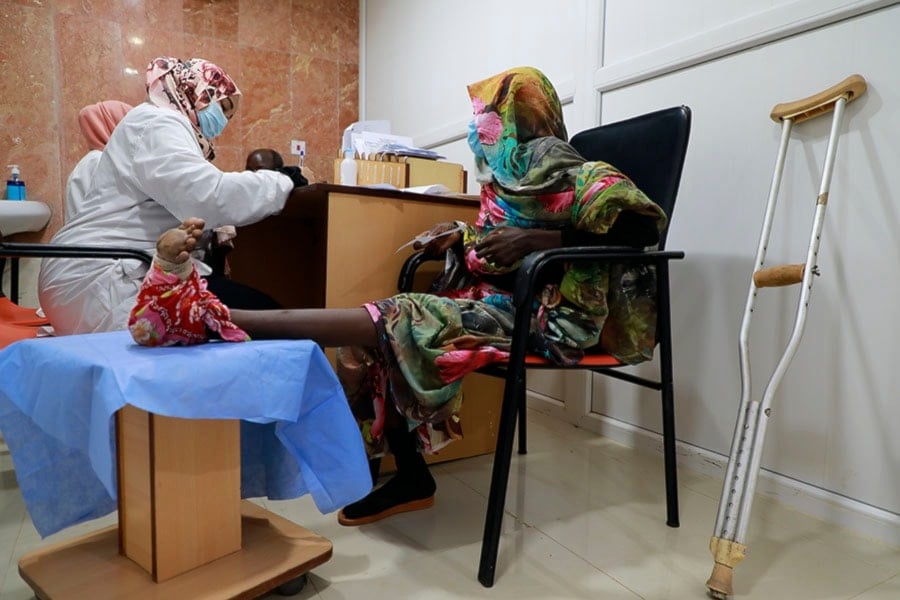Decades of Sudan medical research, health progress in ruins amid war
The conflict in Sudan has destroyed key labs and universities, including the world’s only mycetoma center, erasing decades of medical research and endangering lives.
-

A Sudanese woman gets treated at the Mycetoma Research Centre in Khartoum in an undated photo (Mycetoma Research Centre website)
Sudan’s ongoing conflict has devastated the country’s scientific and medical infrastructure, with once-renowned laboratories in Khartoum now in ruins, The Guardian reported.
According to the publication, over 100 universities and research centers, many among Africa’s most respected, have either been looted or destroyed since the conflict erupted. Professor Ahmed Fahal, a leading Sudanese scientist, told The Guardian that his life’s work was annihilated when the Mycetoma Research Center (MRC) was reduced to rubble. “All that I did over 40 years has turned to ashes before my eyes,” he said.
The destruction has brought scientific progress to a standstill. Fahal’s center, once filled with trained clinicians and researchers in white coats, is now a pile of debris. “I built everything from scratch. I knew every corner, every brick,” he told The Guardian.
Founded in 1991, the MRC was the only facility in the world focused solely on mycetoma, a neglected tropical disease affecting impoverished rural workers, The Guardian explained. The publication detailed how the center housed rare fungal and bacterial samples, a genetic research archive, a fully stocked pharmacy, and three ultrasound machines, all of which have been lost. The only surviving records were digital patient files.
According to The Guardian, the center had treated approximately 12,000 patients over the decades. Sudan has the highest number of documented mycetoma cases worldwide. The disease, caused by fungi or bacteria and spread by thorn pricks, primarily affects children, herders, and farmers working barefoot. Without treatment, it can cause extreme deformities, disability, and in severe cases, death.
Sudan’s war halts treatment for thousands of patients
Just five days before the conflict broke out in April 2023, Fahal returned to Sudan from Switzerland and Japan after presenting clinical trial results on fosravuconazole, a potential breakthrough treatment for mycetoma, The Guardian reported. Two days later, he fled to Egypt as conflict engulfed the capital.
The Guardian noted that while the drug had been approved by Sudan’s National Medicine and Poisons Board, the war halted its rollout. With the first-line drug itraconazole no longer available, over 12,000 patients are left without medication.
Dr. Borna Nyaoke-Anoke of the Drugs for Neglected Diseases initiative (DNDi) told The Guardian that the war has suspended all treatment programs. Fahal added that without medication, infections quickly escalate, often leading to sepsis or amputation. “Many have died, but we don’t have the figures,” he said.
🎙️ The world’s only @MycetomaRC was destroyed in the war in Sudan.
— Drugs for Neglected Diseases initiative (@DNDi) May 7, 2025
On @bbcworldservice's #HealthCheck podcast, @bornanyaoke explains what mycetoma is and why it’s so neglected. @ProfAHFahal reflects on what this loss means for patients.
🎧 Listen here: https://t.co/fygOGEygML
Stranded in Cairo without a work permit, Fahal has only managed to treat three patients, informally, in places like cafes and public squares, The Guardian reported. “I used to see 200 patients a week. Now I can’t even see one,” he lamented.
Still, he continues to write proposals and seek international support. But as he told The Guardian, major donors have turned their attention elsewhere. “Organizations are directing their funds to Gaza or Ukraine,” he said, “because for them, mycetoma is not a priority.”
Scientists warn of disease risk as labs are looted
The Guardian also highlighted concerns from microbiologists about the uncontrolled destruction of sensitive laboratories. Professor Marmar A El Siddig of the University of Khartoum told the outlet that approximately 95% of Sudan’s scientific facilities have been damaged or destroyed.
Particularly alarming, she said, was the loss of her microbial culture collection unit, which stored over 200 strains of Salmonella. “This poses a high risk of disease spread into the environment,” she warned.
The destruction of the Sudan Natural History Museum and the Institute of Endemic Diseases, where vaccines were developed from snake and scorpion venom, adds to the health threats. The World Health Organization, as cited by The Guardian, estimates that 70–80% of health facilities in conflict zones are either closed or barely functional.
A Health Science Reports paper, referenced in The Guardian, noted that Sudan’s public health system is on the brink of collapse, having already suffered over $700 million in losses as national funding is diverted to military operations.

 4 Min Read
4 Min Read








